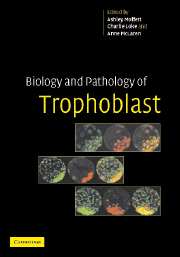Book contents
- Frontmatter
- Contents
- List of contributors
- List of participants
- Preface
- Chair's introduction
- 1 Trophoblast cell fate specification
- 2 Stem cells: pluripotency and extraembryonic differentiation in the mouse
- 3 Epigenetic regulation of trophoblast development
- 4 Regulation of X-chromosome inactivation in relation to lineage allocation in early mouse embryogenesis
- General discussion I
- 5 Gestational trophoblastic disease
- 6 Trophoblast and the first trimester environment
- 7 Implantation is a sticky situation
- 8 Trophoblast regulation of maternal endocrine function and behaviour
- General discussion II
- Final general discussion
- Index
- Plate section
- References
5 - Gestational trophoblastic disease
from General discussion I
Published online by Cambridge University Press: 07 August 2009
- Frontmatter
- Contents
- List of contributors
- List of participants
- Preface
- Chair's introduction
- 1 Trophoblast cell fate specification
- 2 Stem cells: pluripotency and extraembryonic differentiation in the mouse
- 3 Epigenetic regulation of trophoblast development
- 4 Regulation of X-chromosome inactivation in relation to lineage allocation in early mouse embryogenesis
- General discussion I
- 5 Gestational trophoblastic disease
- 6 Trophoblast and the first trimester environment
- 7 Implantation is a sticky situation
- 8 Trophoblast regulation of maternal endocrine function and behaviour
- General discussion II
- Final general discussion
- Index
- Plate section
- References
Summary
Introduction
Gestational trophoblastic diseases (GTD) are a group of diseases involving abnormal proliferation of trophoblastic tissue. They include the benign condition hydatidiform mole (HM), both partial (PHM) and complete (CHM), invasive mole (IM) and the overtly malignant tumours, choriocarcinoma (CC) and placental site trophoblastic tumour (PSTT). Complete hydatidiform mole and PHM are unique in having two copies of the paternal genome. Gestational trophoblastic tumours (GTT) are unusual malignancies in that they are allografts, derived from a conceptus and not from host tissue and are potentially curable even when widely disseminated.
Hydatidiform moles
The abnormal pregnancy HM is characterised by placental overgrowth and abnormal fetal development. In the UK approximately 1 in 700 pregnancies develop as a HM (Bagshawe et al. 1986). The incidence of GTD varies widely and has been reported to be considerably higher in some parts of Asia and South America (Bracken 1987, Palmer 1994). Interestingly, recent evidence suggests that the incidence of HM may now be declining in some areas (Kim et al. 1998, Matsui et al. 2003). Molar pregnancies may be classified on the basis of both pathology and genetics as CHM or PHM (Vassilakos & Kajii 1976, Vassilakos et al. 1977, Szulman & Surti 1978a, b). Both are more common in young women and in women over 45 years of age (Sebire et al. 2002).
- Type
- Chapter
- Information
- Biology and Pathology of Trophoblast , pp. 74 - 110Publisher: Cambridge University PressPrint publication year: 2006
References
- 1
- Cited by

